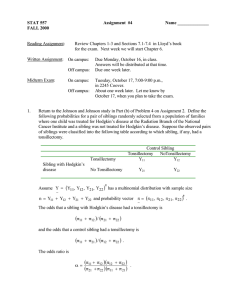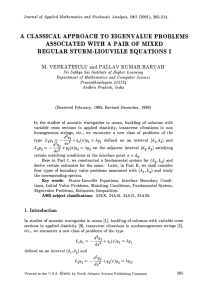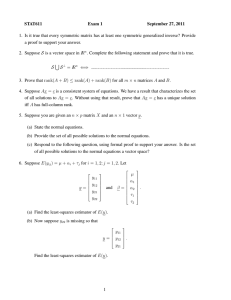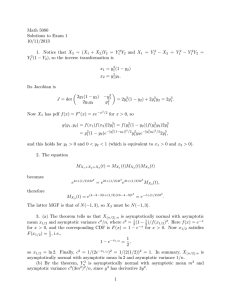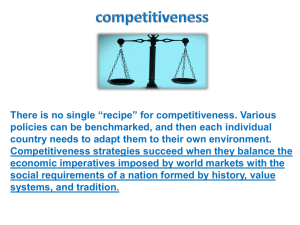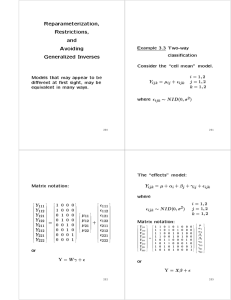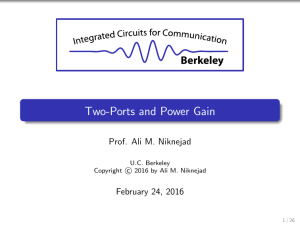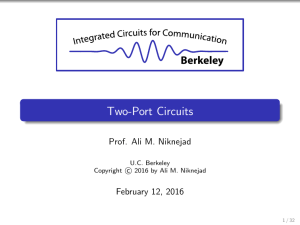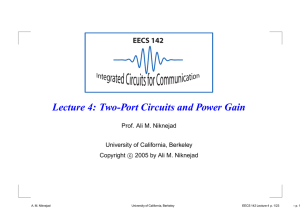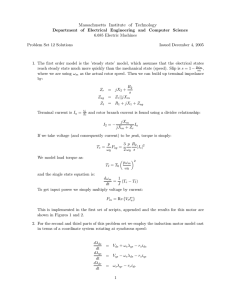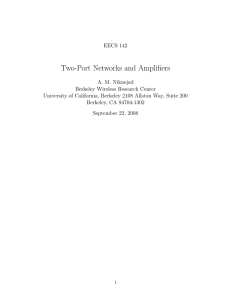PAIR EQUATIONS A WITH A
advertisement
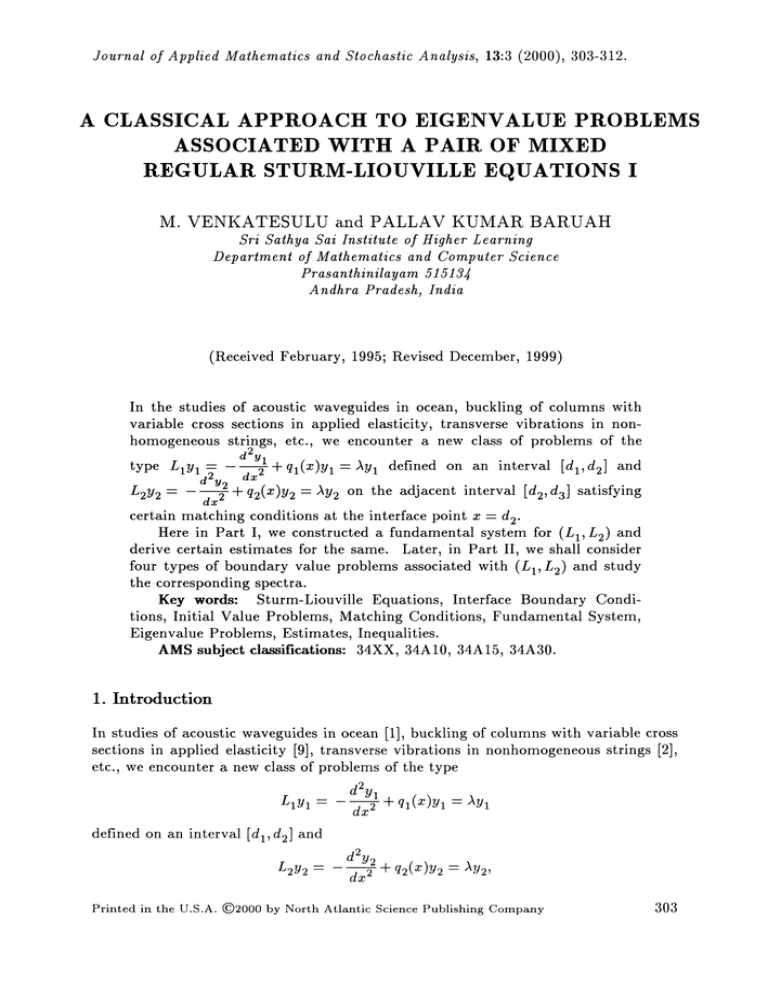
Journal
of Applied Mathematics
and Stochastic Analysis, 13:3
(2000), 303-312.
A CLASSICAL APPROACH TO EIGENVALUE PROBLEMS
ASSOCIATED WITH A PAIR OF MIXED
REGULAR STURM-LIOUVILLE EQUATIONS I
M. VENKATESULU and PALLAV KUMAR BARUAH
Sri Sathya Coal Institute of Higher Learning
Department of Mathematics and Computer Science
Prasanthinilayam 51513
A ndhra Pradesh, India
(Received February, 1995; Revised December, 1999)
In the studies of acoustic waveguides in ocean, buckling of columns with
variable cross sections in applied elasticity, transverse vibrations in nonhomogeneous strings, etc., we encounter a new class of problems of the
type L
L2Y 2
d2 yl
lyldy ---2-rUl(
X
)Yl- "Yl
+ q2(x)y2 .y2
[dl,d2] and
[d2, d3] satisfying
defined on an interval
on the adjacent interval
certain matching conditions at the interface point x- d 2.
Here in Part I, we constructed a fundamental system for (L1,L2) and
derive certain estimates for the same. Later, in Part II, we shall consider
four types of boundary value problems associated with (L1,L2) and study
the corresponding spectra.
Key words: Sturm-Liouville Equations, Interface Boundary Conditions, Initial Value Problems, Matching Conditions, Fundamental System,
Eigenvalue Problems, Estimates, Inequalities.
AMS subject classifications: 34XX, 34A10, 34A15, 34A30.
1. Introduction
In studies of acoustic waveguides in ocean [1], buckling of columns with variable cross
sections in applied elasticity [9], transverse vibrations in nonhomogeneous strings [2],
etc., we encounter a new class of problems of the type
d2yl ql(x)Yl
"Yl
dx 2
defined on an interval
[dl, d2] and
L2y 2
Printed in the U.S.A.
(C)2000 by North
d2y2
dx 2
+ q2(x)Y2 )Y2,
Atlantic Science Publishing Company
303
M. VENKATESULU and P.K. BARUAH
304
,
defined on the adjacent interval [d2, d3] where is an unknown constant (eigenvalue)
and the functions Yl, Y2 are required to satisfy certain matching conditions at the
interface x- d 2. In most of the cases, the complete set of physical conditions give
rise to (selfadjoint) eigenvalue problems associated with the pair (L1,L2). The
spectral analysis of these boundary value problems (BVPs) can be carried out to some
extent by recasting them as operator equations in an appropriate abstract space [3,
8]. But some of the nice and useful properties of the original BVPs cannot be
captured so easily in the abstract space settings. In the literature, there do not seem
to exist may results in this area. However, O.H. Hald [5] discusses the inverse theory
of some problems of this type which arise in torsional modes of the Earth, and B.J.
Harris [6] obtains series solutions for certain Riccatti equations with applications to
Sturm-Liouville problems
Hence here and in the sequel, we adopt the classical approach for the study of
eigenvalue problems (EVPs) associated with the pair (L1,L2) and prove a few
spectral analysis results for the new class of BVPs.
Before proceeding to the work, we shall introduce a few notations and definitions.
Let R denote the real line, and C denote the complex plane with their usual
Re, and ImA denote the real and imaginary
topologies. For a complex number
parts of
respectively. For any two nonempty sets A and B, A\B denotes the
collection of elements in A which are not in B. Again, for any two nonempty sets V 1
and V2, V 1 x V 2 denotes the Cartesian product (space equipped with the product
topology) of V 1 and V2, taken in that order. For a compact interval In, b], of R,
L[a,b] (L[a,b]) denotes the complex (real) Hilbert space of all complex (real)
valued Lebesgue square integrable functions defined on [a,b]. The inner product
in L[a, b] (L2R[a, b]) are given by
(.,.)andnorm
,
,
II" I
b
(f,a)
f- dx and
I fI
(f, f)/2
a
where y denotes the complex conjugate of g. For a function y, y’ and y" denote the
first and second order derivatives of y, respectively, if they exist. Let AC2[a,b]
denote the space of all twice continuously differentiable complex valued functions y
defined on [a,b] such that y’ is absolutely continuous. Let H2c[a,b] denote those
functions y E AC2[a,b] such that y" L2c[a,b]. Let 0 < h < 1 and let (ql,q2)
1]. Let w I and w 2 be nonzero constants.
L[O,h] x
We consider the pair of Sturm-Liouville equations
L[h,
LlYl
L2Y2
YI + ql(x)yl
yl, O <_ x <_ h,
-Y’2’ + q2(x)Y2 Y2,
h
(1)
< x < l,
together with the matching conditions at the interface x- h given by
,
Yl(h)- Y2(h), WlYi(h)
where is a complex constant.
Definition 1" By a solution of the problem
{Yl, Y2} satisfying the following conditions:
w2Y2(h)
(1)-(3),
(3)
we mean a pair of functions
A Classical Approach to EVPs, ETC. I
(i)
(ii)
(iii)
Yl @
Y2
305
AC2[O, hI and satisfies Equation (1) for almost all x E [0, hi,
AC2[ h, 1] and satisfies Equation (2) for almost all x [h, 1],
Yl,Y2 satisfy the matching conditions (3).
Definition 2: We say that the nontrivial pairs {Y11,Y12},{Y21,Y22} where Yll,Y21
are defined on [0, hi and Y12, Y22 are defined on [h, 1] are linearly independent if for
any two scalars a and/, the equations
-
cY11(X)-- Y21(X)
ozYl2(X
[0, hi and
0 for all x
Y22(x)
[h, 1]
0 for all x
0.
Definition 3: By a fundamental system (FS) for the problem (1)-(3), we mean a
set of two linearly independent solutions of (1)-(3), which span the solution space of
imply a
(1)-(3).
In Part I, we construct a FS for the problem (1)-(3) and establish certain estimates
for the components of FS. In Part II, we present results concerning the location of
the spectra of various associated BVPs.
2. A Fundamental System for
(1)-(3)"
Construction and Estimates
sinv/x Before
For the sake of simplicity, we denote C,()= (cosv/) and S,()=---proving the main theorem, we state the following easily verified lemmas.V/’
Lemmal: Let (gl,g2) eL2c[0, h]xL2c[h, 1 ]. Then for x e [h, 1],
h
x
/ Igl(t) + / Ig2(t)
dt
o
h
dt
-
(ll gl ]]2 + I] g2 I 2)1/2V/"
Lemma 2: (A) The problem (1)-(3) along the initial conditions
Yl(0)
1, y(0)
(4)
0
is equivalent to the Liouville integral equation
x
yl(x)
CA(x +
/ S(x- t)ql(t)yl(t)dt
O<_x<_h,
o
Y2(X) yl(h)CA(x- h)+ (Wl/w2)Yl(h)SA(x- h)
x
+
/ S),(x-t)q2(t)y(t)dt
h
<_ x <_
1.
(6)
h
(B)
The problem
(1)-(3) along
with the initial conditions
y(O)
O, y’l(O)
is equivalent to the Liouville integral equation
1
(7)
-
M. VENKATESULU and P.K. BARUAH
306
yl(x)- SA(x
x
/ SA(x-- t)ql(t)Yl(t)dt
0
<_ x <_ h,
(8)
o
Yl(h)C)(x- h) + (Wl/W2)Yl(h)A(x h)
y2(x)
x
+
j S(x- t)q2(t)y2(t)dt
(9)
h<_x<_l.
h
Theorem 1: (Construction of a FS for (1)-(3)) (A) The unique solution
value problem (1)-(4) is given by the pair (11’Y12) where
CA(x)+
Yll (x)
E
n=l
_< t, _<
o_<t I
,k(ti -t- 1 ti)ql(ti)dt ’’’dtn,
Y12 (x)
E
Co(x’ ") +
n=l
Co(x,,
0
CA(t1)
i=1
=z
+
<_ x <_ h,
C0(tl’ ))
h
<_
1
<_
<_ tn <_ tn_t_ 1
/=1
x
Y11(h)C(x- h) +2(Y11(h)S(x h)),
(B) The unique
(Y21, Y22) where
of initial
solution
(10)
ti)q2(ti)dtl’" "dtn, h < x < 1,
S(ti +
where
,
of initial
value problem
(1)-(3)
(11)
h
<_ x <_
and
(7)
1.
(12)
is given by the
pair
n=l
X
Y22 (x)
SA(t
<_...<_tn<_tn+
i=1
=x
ti)ql(ti)dtl" "dtn, 0 < x < h,
h-
SO(X’ ) -"
O<_t I
E
n=l
SA(ti +
(13)
So(t1’ )
h<t
<...<_tn<tn+
i=1
1 =x
ti)q(ti)dtl.. "dtn, h < x < 1,
(14)
where
Coo(X,
Here
Wl
h)),
Y21(h)CA(x h) q-2(Y21(h)CoA(x
h
<_ x <_
1.
(15)
A Classical Approach to EVPs, ETC. I
307
2
/
<_..._t n _t n+l---x
0<_
and
0
0
0
2
x
h<_t 1
...dl...d
/
d’l""d’n-/
/
.../
<_...<_tn<_tn+
h
=x
n.
h
h
Proof: We prove part (A). The proof of part (B) follows similarly. Expression
(10) follows from Theorem 1 (on p. 7 [7]). One can also refer to Equation (8) on
page 9 [4], for the power series representations in (10) and (13). Below we derive
Expression (11).
We assume that Y12 is a power series in q2, that is
E Cn(X’’q2)’
Co(X")"nt-
Y12(X)
n=l
where
Cn(x A, q2) Cn(x, A, q12’ "’" qn2) Iql 2
qn2), for each x and A,
times) x L2c[h, 1].
__
....
h
_< x _<
(16)
1
and
Cn(x,A, q12,’",
is a bounded, multilinear symmetric form on
L2c[h, 1] x... (n
q22
q2’
qn2
Formally differentiating the power series for Y12 twice with respect to x and
substituting into Equation (2) then equating the terms which are homogeneous of the
same degree in q2, we obtain
Cg
-C
AC 0
AC n -q2Cn_ 1, n
1, h
(17)
x
<_
(18)
1.
In view of the matching conditions (3) to be satisfied by the pair
interface x- h, we impose the following initial conditions on the
(Y11,Y12)
at the
Cs"
Y11(h), C;(h, )
Co(h, )
Cn(h
Clearly, the solution of
Co(x,,,
Also the solution of
(19)
0, n _> 1.
C’n(h
(17) satisfying (19)
Wl2Y11(h)
(20)
is given by
Wl
h)).
Y11(h)V.x(x h) --k-2(Yll(h),..)(x
(18) satisfying (20)
is given by
x
Cn(x,,q2)
/ S,x(x
t)q2(t)Cn_ l(t, ,q2) d/,
n>l.
h
Proceeding by induction, we get
n
C0(tl’ ")H S)(ti + -ti)q2(ti)dtl...dtn.
h<_t <_...<t
n<tn+ l=x
Substituting the expressions for
Note 1: We note that
Co, C n in (16),
i--1
we obtain
(11).
M. VENKATESULU and P.K. BARUAH
308
Yjl(X)--Yjl(X,,ql)
and
,
Yj2(x) yj2(x, w, w2, q, q2), J
Theorem 2: (A) The formal power series
bounded subsets of [0, h] x C x L[O, h] and
Yjl(X)
(B)
subset
<-- exp( Imvf
x q-
1, 2.
for Yjl, J- 1,2
I ql I /r),
0
converge uniformly on
<_ X <_ h.
1 2 converge uniformly on bounded
formal power series for Yj2,
of [h, 1] C (C\{O}) (C\Br(O)) Lc[O,h] L2c[h, I], for any r > 0 and
2J
The
lyj2(x) l<
1+
1-2
V/
ex
h
(A) follows from Theorem 1 (on p. 7 [7]).
[Y12(x)]. The estimate for ]Y22(x)] can
Proof: The proof of part
shall derive the estimate for
along similar lines.
We note that
C(x) <_
x
l.
Below we
be derived
exp(lImv/lx),
and for 0_<x_<l,
]S,(x)] <_ exp(lImv/-[x), (see p. 8 [7]).
Substituting the series (10) and its derived series for Yll(h) and yl(h), respectively,
into Expression (12), regrouping the terms, taking modulus and using the triangle
inequality, we obtain
+(1- 22)Sn(’-(x- h) )Sin(v/h)
C)(tl)ql(tn) H S)(ti + --ti)ql(ti)
<
W1
C(x)
n--1
1
O_<t l<...<t n
n
i=1
h
+
[S(x- tn)+(-2--1)S(x- h)C(h-tn)]dtl...dt
_< 1+
1-2
xp
IImvlx
1+11-2
n
Iql(ti)
x 1+
n--1
xp(lImv/-lx)x
I
O<_t
<_...<tn<_tn+l_h
Iql(t)
1+
0
dt
ldtl...dtn
i-1
p.
s [7])
A Classical Approach to EVPs, ETC. I
(
We exp
2
ICo(x,,)] _< 1+
1-2
Iql(t) ldt, h<x<l.
(21)
0
(11),
Finally from Equation
Imv/lx +
309
we
get
lYl2(X) _< C0(x,)l
/
n=l
n
Co(tl,,)
x
H S(ti-
1
ti) lq(ti)[dtl"" "dtn
i=1
-<
1
( 1+11 -We)
22
exp
IIXf x+
(t) ldt
0
+
[q2(ti) ldtl...dt n
n=i
h<_t 1
<_...<_tn+
i=1
1 =x
(using (21)and simplifying)
(as before>
_< 1+
1-2
xp
Imv/lx + I ql I
+I I
(by Lemma 1).
_
h
_< x _< 1
(22)
The above estimate readily implies the uniform convergence of the power series for
912"
Note 2: Theorem 2 and Lemma 2 readily imply the uniqueness of the solution stat
in Theorem 1. Moreover, every solution (Yl,Y2) of the problem (1)-(3) is uniquely
expressed in the form
Yl(X) Y1(0)Y11(X) nt- YI(0)Y21(X)’
y2(x)
-
Yl(O)Yl2(X)-- y1(0)Y22(X),
0 _(
Z
h,
h<x<l.
Lastly, we prove the following theorem on the asymptotic estimates for the
components of the FS.
Theorem 3" (A) On [0, hi x C x L[0, hi,
(i)
Yl (x)-
cosv/X
M. VENKATESULU and P.K. BARUAH
310
sin
(ii)
x/fx
(iii)
+
1+
Imv
Wl ea:p(
Y12(X) + X/sinv <_ v/ I1 --1
(vii)
<
1/2
ex ]Imx/lx +( I ql I 2"1" 1 q2 I1 2)
2+
q2
(llqll]
I
I
)1/
1-@-2
Y22(x)- cosx/rx <_
(viii)
-4-
Wl
I1--1
Vf
(l]
2
/( I
ql
ql
I 2 -4- I q2
])2)1/2
I 2-4- I1 q2112)1/2V/’
Proof: The proof of part (A) follows from Theorem 3
inequalities (v) and (vii) of (B). Inequalities (vi) and
similarly.
(v)
x)
")
(p. 13 [7]). We establish
(viii) can be established
From
Co(x,A
+
E
C)(x)
W
+(1 2)Sln(V/(x
h))Sin(v/h)
CA(tl)ql(tn)
n=l
O_<t <_
x
<_ tn <_ tn +
S(X-tn)+
22-1
h
i=1
s,(ti + 1 ti)ql(ti)
S(x-h)C(h-tn)dtl...dt n
A Classical Approach to EVPs, ETC. I
it follows by using the same type of estimating as in
(21)
311
that
c0(,)- cosvX
_<11 -Wlxp(llmv/-l:e/4.
wl])
22
[V/ I14.]1- 22
1
By (11)
exp
(IImv/[4. / )
]ql(,)]dt
o
(23)
Y12(x) Cos(v/-X)
Co(x,/)-CA(x)]
4"n_1-[
n
Co(tl, A)
h<_tl...<tn+l
H qA(ti +
1
ti)q2(ti)dtl’" "dtn
i=1
=X
<]1 Wl xp(I Imv/- I)
)e
xp
(
]Imv/lx +
ql(t) dt
1
+
o
(by using (21), (23) and the second
<[1 _Wlxp(llmv/-lx)+
22
/h
n=11(-. /x )n/
q2(t)
dt
h
sum estimation in
(22))
V/-[ (1+11- 22 I)e ( IImv/-lx+( ]]ql I 2+ ]1q2[[2)
wl
1
1/2
xp
(by Lemma 1).
(vii) Differentiating integral equation (6) for Y12
with respect to x, inserting
and simplifying we obtain
Y11(h), yl(h) from integral equation (5),
Yl2(X)
cos(v/-h)sin(v/(x h)) 4. 2sin(v/-h)cos(x//-(x h))
h
ql(t)Yll(t)
4.
sin(v/(h t))sin(x/(x h))+ 2cos(v/(h t))cos(v/(x- h)) dt
0
x
+
f C)(x-
t)q2(t)ya2(t)dt.
h
Hence
yi2(x) 4" X//-sin(v/rx)
w
h
exp(lmv/;]t
/
o
/
I ql I’
1 4-
1-2 xp(llmv/;](/-t)
2
ql(t)]dt
M. VENKATESULU and P.K. BARUAH
312
h
Iq2(t) ldt (by Theorem 2)
<
Iv l]l Wl xP(I Imv/ Ix )
2+ IIq2
112)l/2exp(Iimv/lx+( Ilql I] 2+ IIq2 112)1/2V/)
(by Lemma 1).
Note 3: It follows from standard results for initial value problems that Yij,
i, j 1, 2 and their derivatives are analytic functions of A.
Acknowledgement
The authors are extremely grateful to the referee for the useful suggestions and
comments which resulted in the present form of the paper. The authors dedicate the
work to the Chancellor of the Institute Bhagawan Sri Satya Sai Baba.
References
[1]
[2]
[3]
[4]
Boyles, C.A., Acoustic Waveguides, Applications to Oceanic Sciences, Wiley,
New York 1984.
Ghosh, P.K., The Mathematics of Waves and Vibrations, MacMillan, India
1975.
Bhaskar, T.G., A Study of Mixed Linear Regular Ordinary Differential
Operators, Ph.D. Thesis, Sri Sathya Sai Institute of Higher Learning 1990.
Borg, G., Eine Umkehrung der Sturm-Liouvillschen Eigenwertaufgabe: Bestimmung der Differentialgleichungs durch die Eigenwerte, A cta. Math. 78 (1946), 196.
[5]
[6]
[7]
Hald, O.H., Discontinuous Inverse eigenvalue problems, Comm. Pure and Appl.
Math XXXVII (1984), 339-377.
Harris, B.J., A series solution for certain Riccatti equations with applications to
Sturm-Liouville problems, J. Math. Anal. Appl. 137 (1989), 462-470.
Poschel, J. and Trubowitz, E., Inverse Spectral Theory, Academic Press, New
York 1987.
[8]
[9]
Venkatesulu, M. and Bhaskar, T.G., Self-adjoint boundary value problems
associated with a pair of mixed linear ordinary differential equations, J. Math.
Anal. Appl. 144:2 (1989), 322-341.
Wang, C.-T., Applied Elasticity, McGraw-Hill, New York 1953.
